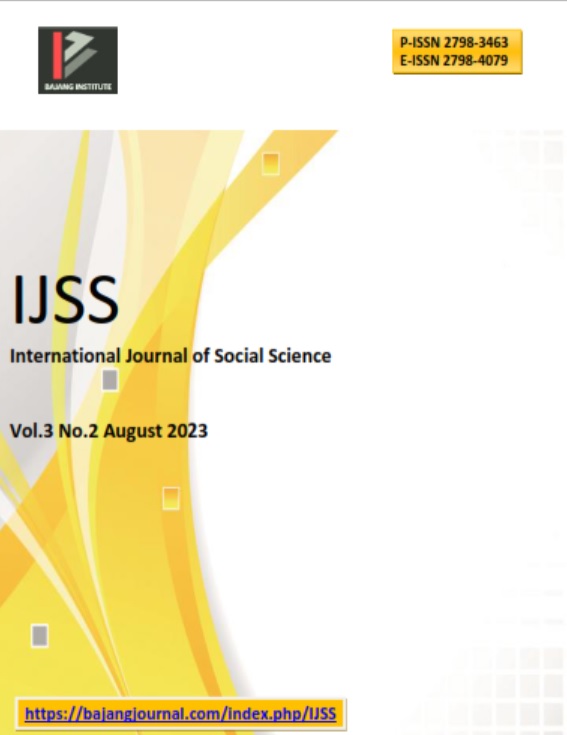LANGUAGE USE IN PUBLIC SPACE (LINGUISTIC LANDSCAPE STUDY IN SHOPPING CENTERS IN MAKASSAR CITY)
DOI:
https://doi.org/10.53625/ijss.v3i2.6295Keywords:
Linguistic Landscape, Shopping Center, Top Down-Bottom-Up, Public SpaceAbstract
The purpose of this research is; 1) describe the linguistic landscape used in the Makassar City shopping center; 2) describe the dominant use of language in the linguistic landscape; and 3) knowing the reasons for using foreign languages in the linguistic landscape in shopping centers in Makassar. This research is a qualitative research designed descriptively. The locus of this research was in three shopping centers in Makassar City, namely Panakukang Mall, Nipah Mall and Ratu Indah Mall. Data is collected through documentation techniques. Analysis was carried out using qualitative techniques through data collection procedures, data reduction, data presentation, and conclusion/verification. The results of the study show that the types of landscapes found in shopping centers in Makassar City are top-down and bottom-up linguistic landscapes. The bottom-up landscape type is dominant in shopping centers in Makassar. In addition, foreign languages, especially English dominate the linguistic landscape in shopping centers in Makassar City. This is motivated by several factors, self-image (business image) and efforts to strengthen brand makers as an attraction for consumers
References
Landry, R., & Bourhis, B. (1997). Linguistic landscape and ethnolinguistic vitality: An empirical study. Journal of Language and Social Psychology, 16(1), 23-49. doi: 10.1177/0261927X97016100.
Gorter, D. (2018). Methods and techniques for linguistic landscape research: About definitions, core issues and technological innovations: In M. Pütz &N. Mundt (eds.), Expanding the linguistic landscape:linguisti cdiversity,
multimodality and the use of space as a semiotic resource (pp 38–55). Bristol: Multilingual Matters. doi: 10.21832/PUTZ2159.
Oktaviani, E. (2019). Linguistic landscape: A case study of shop names in Gresik Kota Baru (GKB), Gresik (Bachelor thesis, Universitas Islam Negeri Surabaya, Surabaya). Retrieved from http://digilib.uinsby.ac.id/30926/.
Prieto, R. S. (2019). Examining language policy and practices on the ground: German and French in the public space of two walloon municipalities with language facilities. Lebende Sprachen, 64(1), 78-102. doi: 10.1515/les-2019-0004.
Purschke, C. (2017). (T)apping the linguistic landscape. Linguistic Landscape, 3(3), 246-266. doi: 10.1075/ll.17023.pur.
Tyas, A. S. P. (2017). Identifikasi Kuliner Lokal Indonesia dalam Pembelajaran Bahasa Inggris. Jurnal Pariwisata Terapan, 1(2), 1-14. doi: 10.22146/jpt.24970.
Rahman, F. (2018). Kuliner sebagai identitas keindonesiaan. Jurnal Sejarah, 2(1), 43- 63. doi: 10.26639/js.v%vi%i.118.
Ramadhani, A. R. (2018). Lingua franca in the linguistic landscape of Gresik Kota Baru. Etnolingual, 2(2). doi: 10.20473/etno.v2i2.10569.
Wadhaugh, R. (1980). Introduction to Sociolinguistics. Oxford: Basil Blackwell.
Wang, S. (2005). Discourses in place: Language in the material world. Journal of Pragmatics, 37(5), 769-773. doi: 10.1016/j.pragma.2004.03.005.
Wong, A. S. H., & Chan, S. S. S. (2018). heritage and gaming tourism. Journal of Multilingual and Multicultural Development, 40(3), 198-217. doi: 10.1080/01434632.2018.1498853.
Yannuar, N., & Tabiati, S. E. (2016). Public Signs in the City of Malang: A Study on the Linguistic Landscape of Indonesia. In V. N. Santi, M. Huda, A. Himmah (Eds.), Proceedeng of the 3rd Forum Linguistics and Literature (FOLITER) (pp. 123-138). Malang, Indonesia: Maulana Malik Ibrahim State University.
Yuan, M. (2019). Submission and resistance in the English linguistic landscape of
Chaoshan. English Today, 35(2), 20-28. doi: 10.1017/S0266078418000214.
Yuliawati, S. (2014). Analisis berbasis korpus: Kolokasi kata-kata bermakna
‘perempuan’ dalam media Sunda (majalah Mangle, 2012--2013). Ranah,
(1), 107–23.
Zhang, Hui, and Ruanni Tupas. (2020). English-Dominated Chinatown. Journal of
Asian Pacific Communication. doi: 10.1075/japc.00052.zha.
Downloads
Published
How to Cite
Issue
Section
License
Copyright (c) 2023 Syamsurijal Syamsurijal, Ery Iswary

This work is licensed under a Creative Commons Attribution 4.0 International License.

















